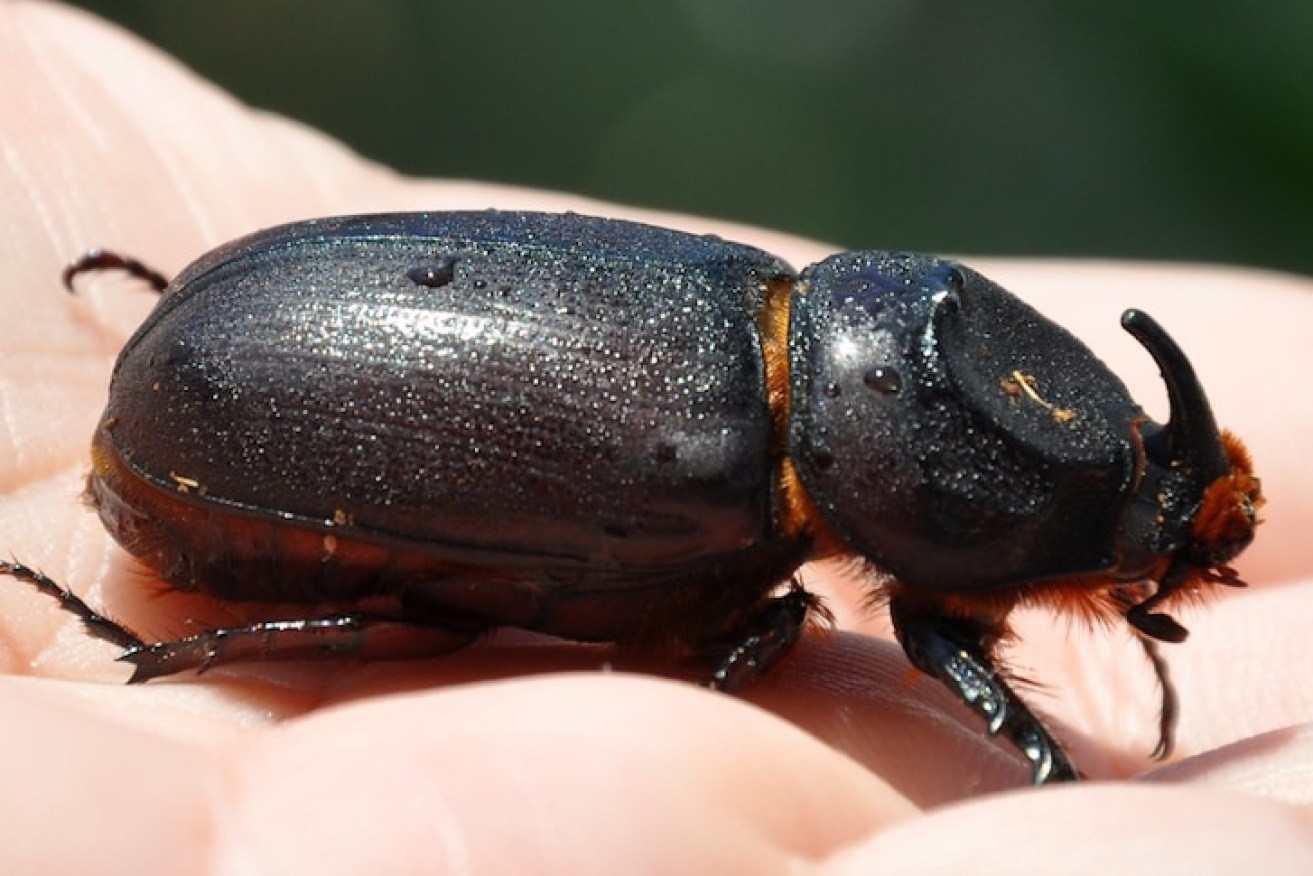Is our wobbly biosecurity shield strong enough to keep out this giant beetle?
Researchers are in a race against time to stop a destructive beetle edging closer to Australia, as new outbreaks of fire ants erupt in south east Queensland, and doubts persist about whether our biosecurity shield is up to the job.


Supplied image of the coconut rhinoceros beetle (ABC)
The palm-loving coconut rhinoceros beetle is still happily munching its way across the South Pacific, destroying home gardens, plantations and biodiversity in the already fragile environments and economies of our nearest neighbours.
It has a very specific diet – plant material from palm trees – but isn’t so picky when it comes to its sexual appetites, as it breeds with other beetle species and further confounds scientists charged with curbing their spread via biological controls.
If any of the pests hitch a ride on a trading vessel, and successfully penetrate our biosecurity net, the state’s ornamental palm industry, worth an estimated $100 million according to the Nursery Garden Industry of Queensland, could be first in the firing line.
Fledgling horticulture industries, such as date palms, would also be at risk, not to mention the many palm trees that adorn thousands of Queensland properties – both residential and commercial.
University of Queensland researcher Dr Kayvan Etebari has been studying how coconut rhinoceros beetles have been accelerating their invasion.
“We thought we’d outsmarted them,” Etebari said.
“In the 1970s, scientists from Australia and elsewhere found that coconut rhinoceros beetles could be controlled with a beetle virus from Malaysia.
“This virus stopped the beetle in its tracks and, for the last 50 years or so, it more-or-less stayed put – that is, until now.
“It seems that they are now unshackled from the virus in some places and could be in Australia before we know it.”
Playing with fire
The scenario is eerily reminiscent of the fire ant threat, before the first colonies infiltrated Queensland in 2001 in a container ship landed at the Port of Brisbane.
Authorities knew they were an imminent threat – they just didn’t know when or where they would strike.
Etebari and his UQ colleague Professor Michael Furlong, say there have been no recorded incursions of the coconut rhinoceros beetle in Queensland.
But it’s a long coastline to protect, and the pest currently has us surrounded, on islands in PNG, the Solomons, Samoa, Fiji, New Caledonia, Tonga, Vanuatu and the Philippines.
Neither researcher can say with any certainty that the pest is not already here, or could arrive at any time and unnoticed until it gains a foothold, such as the fall armyworm from Central America, which slipped into Queensland via the Torres Strait last year and is now menacing crops in NSW, Victoria and WA.
As Etebari and Furlong step up the urgency, Department of Agriculture teams south of Brisbane are increasing surveillance and controls in ten new locations within the Scenic Rim and Somerset Regional Council areas.
The undertaking is part of the National Red Imported Fire Ant Eradication Program, a nationally cost-shared scheme funded by all Australian state and territory governments, and the federal government.
The new zones, which have been established in areas such as Fernvale in the Brisbane Valley, and several communities near Beaudesert such as Josephville, Kerry and Canungra, are in place to stop fire ants from spreading through human-assisted movement of infested material.
Fire ants can also fly as far as five kilometres from infested areas, making the mission to eradicate the colonies even more challenging.
Despite being under siege from the invasive ants, in an area known for its highly-productive dairy farms, boutique beef operations, elite horse studs and eco-tourist outlets, Scenic Rim Mayor Greg Christensen says he is comfortable with the program’s approach.
“It’s obviously very concerning and we’ve been working closely with DAF and their biosecurity teams and they have been very proactive,” he said.
“They are extremely active in conducting surveillance and informing the community about what they can do to contain the spread of fire ants.
“It’s not severe at this stage, but it certainly requires vigilance from everyone in this region to ensure it doesn’t get out of hand.”
A spokesperson for the fire ant program said Australia was the first country in the world to attempt eradication at scale.
“Without the program, it’s estimated fire ants would have now spread north to Bowen, west to Longreach and south to Canberra,” the spokesperson said.
“Significant progress has been made with about 30 per cent of the total infested area receiving broad-scale treatment and now undergoing clearance surveillance.”
But the operation hasn’t come cheap.
According to Queensland Farmers Federation CEO Dr Georgina Davis, governments have allocated $411 million to the National Red Imported Fire Ant Eradication Program, while Tuesday’s 2021-22 State Budget included increased funding of $8.8 million over four years for biosecurity operations in the state.
But it may not be enough without citizen help, says Davis.
“Everyone, from farmers to people in inner Brisbane, need to do their bit,” she said.
“All Queenslanders have a general biosecurity obligation to manage biosecurity risks and must play their part to maintain Australia’s relative pest, disease and weed freedom.
“It is imperative that all Australians and visitors adhere to biosecurity requirements both on-farm and in general, and report suspected breaches to Biosecurity Queensland immediately.”
Turning up the heat
The expensive and resource-sapping experience of controlling invasive pests once established in the Australian ecosystem, is motivating Etebari and Furlong to raise the volume on their calls for more action overseas – something akin to a forward-defence policy to protect our domestic interests.
But the enemy is proving a resilient and inventive adversary, so far impermeable to any clear-cut solutions offered by the pair and their team of international experts in a Pacific regional engagement exercise funded by the Australian Centre for International Agricultural Research and the University of Queensland.
In the last few years, the pest has spread to many South Pacific islands, including islands in Papua New Guinea, the Solomon Islands and Vanuatu, causing severe agricultural and economic damage.
Furlong said the research team investigated the beetle’s population genetics and the incidence of the virus in specimens collected in Fiji, New Caledonia, Papua New Guinea (PNG), Samoa, Solomon Islands, Tonga, Vanuatu and the Philippines.
“We found that there have been several new waves of beetle invasions, not only one as we first expected,” Furlong said.
“And there are different populations of the beetle that we didn’t recognise previously – in the Solomon Islands for example, there are three populations of the beetle, and they are interbreeding.”
The beetles all look alike, but the molecular tests show they are different.
“Similar to how scientists spot different strains of COVID-19, we are also detecting variations in the beetle virus,” Furlong said.
“This presents us with a complex problem: multiple types of beetles and beetle-controlling virus.
“The next step will be finding out how these virus variations behave in these different beetles, and how this can be used to control them.
“We know the virus doesn’t kill the beetles outright, but probably affects the number of eggs a female lays and changes beetle behaviour, for example how far infected beetles can fly, so we need to explore these important aspects of the interaction too.”
Etebari said investing in research and new control methods was vital, not only for Australia’s prosperity, but for humanitarian reasons.
“The coconut rhinoceros beetle remains a serious threat to livelihoods across Pacific islands, where the coconut tree remains their ‘tree of life’, providing essential resources like food, copra, building materials and coastal protection for five million vulnerable people,” he said.
“It’s imperative that Australian scientists help our neighbouring countries in the Pacific to tackle their emerging pests and diseases.
“And everything we’re finding in the Pacific islands may later be critical to managing the beetle here in Australia.”









